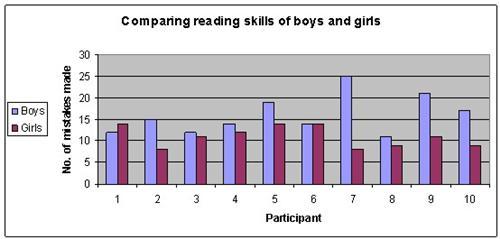| Complexity level: | 4 |
| Time required: | 1 hour for preparation and a day for to conduct the reading tests |
| Material availability: | You will need access to a quiet room and the assistance of an English teacher |
| Safety concerns: | None |
Hypothesis
Girls are better at reading than boys.
Overview
Reading and gender
Most studies done recently show that girls are outperforming boys on reading assessments. Studies have also found that nearly 50% of girls read for at least 30 minutes a day compared to only 30% of boys who do the same.
Reading assessments conducted at international levels indicate that girls are outperforming boys in their reading skills. The National Assessment in Educational Progress (NEAP) conducted in the United States has indicated that the reading standards of boys is on the decline, whereas the reading level of girls is on the rise.
Researchers recently found that boys and girls process language differently. Boys tend to process language using the sensory parts of the brain. This means that when boys are reading and listening, they tend to use the visual and auditory parts of the brain. As for girls, when they are reading, they tend to use the part of the brain that processes language and abstract thinking. These findings were determined through the use of functional Magnetic Resonance Imaging (fMRI) on boys and girls aged 9 to 15 while they were writing and spelling.
Scientific Terms
Materials
The materials required for the experiment:
- 10 boys and 10 girls (15 years of age)
- A 500 word text
- An English teacher
- A room for the oral test
Procedure
1. For this experiment, the independent variable is the gender of the person who is taking the oral reading test. The dependent variable is the number of mistakes made by the participant during the test. This is determined by counting the number of mistakes made during the reading. The constants (control variables) are the age of the students, the environment in which the test is conducted, the time of day at which the test is conducted and the difficulty of the text passage.
2. A 500 word text passage is chosen for the participants to read aloud.
3. The assistance of an English teacher is sought to help evaluate the reading skill of the participants. The English teacher will be required to identify mispronunciations and any words omitted during the oral test.
4. On the day of the experiment, the participants wait outside the examination room. They are then called in individually to read out the 500 word text passage to the English teacher. The test is conducted as follows:
a. the student enters the room and is seated in front of the teacher
b. the 500 word text is presented to the student
c. the student is required to read the text aloud
d. the teacher listens to the text being read out . She identifies and records mistakes in:
i. mispronunciations
ii. words that are missed
iii. failing to pause at appropriate abbreviations, eg. coma, etc.
5. After each participant has completed the oral reading test, the teacher will record the number of mistakes made by the student in the table given below


Results
The results show that the boys had made an average of 16 mistakes while reading the 500 word text compared to only 11 mistakes by the girls.

The graph below represents our findings

Conclusion
The hypothesis that girls are better at reading than boys is proven to be true. On the average, the girls made fewer mistakes than the boys when reading the 500 word text.
Considering how important reading skills are in the general development of a person, a country’s literacy levels can in turn significantly affect it’s social progress and economic output. .
Also consider
The experiment can be repeated on students from different age groups.
Try to repeat the experiment by getting the students to read the passage again and then test them further with questions to check their levels of understanding of the passage.
References
Boys’ and girls’ brains are different – gender differences in language appear biological - http://www.sciencedaily.com/releases/2008/03/080303120346.htm
Girls and boys – the gender reading gap - http://www.readfaster.com/articles/the-gender-reading-gap.asp

